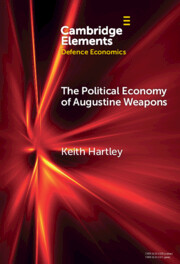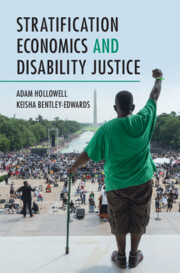Refine search
Actions for selected content:
526 results
4 - Development and Growth
-
-
- Book:
- Explaining the History of American Foreign Relations
- Published online:
- 24 October 2025
- Print publication:
- 13 November 2025, pp 82-102
-
- Chapter
- Export citation
1 - Introduction
- from Part I - Preliminaries
-
- Book:
- Animal Economics
- Published online:
- 18 November 2025
- Print publication:
- 13 November 2025, pp 3-44
-
- Chapter
- Export citation

The Political Economy of Augustine Weapons
-
- Published online:
- 30 October 2025
- Print publication:
- 27 November 2025
-
- Element
- Export citation
Chapter 6 - Bloomsbury and Music
- from Part I - Aesthetic Bloomsbury
-
-
- Book:
- A History of the Bloomsbury Group
- Published online:
- 09 October 2025
- Print publication:
- 23 October 2025, pp 86-101
-
- Chapter
- Export citation
Chapter 19 - Bloomsbury and Economics
- from Part IV - Public Bloomsbury
-
-
- Book:
- A History of the Bloomsbury Group
- Published online:
- 09 October 2025
- Print publication:
- 23 October 2025, pp 317-333
-
- Chapter
- Export citation
1 - Usefulness, Loyalty, and Property
-
- Book:
- God, Slavery, and Early Christianity
- Published online:
- 19 September 2025
- Print publication:
- 09 October 2025, pp 48-90
-
- Chapter
- Export citation
14 - Advancing One Health Legal and Policy Action for the Environment
- from Part III - One Health and Future Legal Structures
-
-
- Book:
- The Cambridge Handbook of One Health and the Law
- Published online:
- 25 September 2025
- Print publication:
- 09 October 2025, pp 216-229
-
- Chapter
- Export citation
10 - Mobility, Livability, and Sustainability
- from Part II - Application Case Chapters
-
- Book:
- Cities and Environmental Change
- Published online:
- 15 August 2025
- Print publication:
- 28 August 2025, pp 215-242
-
- Chapter
- Export citation
Chapter 10 - Bringing Economics and Business into educational settings
- from Part II - HASS concepts and sub-strands
-
-
- Book:
- Making Humanities and Social Sciences Come Alive
- Published online:
- 02 August 2025
- Print publication:
- 14 August 2025, pp 171-190
-
- Chapter
- Export citation
Chapter 13 - The Logics and Rhetorics of Theft in 1970s Feminist Writing
- from Part II - Histories
-
-
- Book:
- Money and American Literature
- Published online:
- 03 July 2025
- Print publication:
- 17 July 2025, pp 223-239
-
- Chapter
- Export citation
Introduction
-
-
- Book:
- Money and American Literature
- Published online:
- 03 July 2025
- Print publication:
- 17 July 2025, pp 1-22
-
- Chapter
- Export citation
Making care primary: a renewed investment into primary care
-
- Journal:
- Health Economics, Policy and Law , First View
- Published online by Cambridge University Press:
- 15 July 2025, pp. 1-11
-
- Article
-
- You have access
- Open access
- HTML
- Export citation

Stratification Economics and Disability Justice
-
- Published online:
- 21 June 2025
- Print publication:
- 05 June 2025
1 - Economics and the Environment
- from Part I - Introduction and Key Concepts
-
- Book:
- Economics for a Sustainable World
- Published online:
- 14 July 2025
- Print publication:
- 12 June 2025, pp 3-31
-
- Chapter
- Export citation
1 - The Family and Its Problems in the History of Economics
-
- Book:
- Economics and the Family
- Published online:
- 08 May 2025
- Print publication:
- 05 June 2025, pp 1-35
-
- Chapter
- Export citation
Chapter 7 - Mary Prince
-
-
- Book:
- The Cambridge Companion to Mary Prince
- Published online:
- 24 April 2025
- Print publication:
- 08 May 2025, pp 120-134
-
- Chapter
- Export citation
3 - Commerce and Culture
- from Part I - From Sovereigns to Wards
-
- Book:
- Becoming Nations Again
- Published online:
- 17 April 2025
- Print publication:
- 24 April 2025, pp 38-51
-
- Chapter
-
- You have access
- Open access
- HTML
- Export citation
The economic performance of soil health practices in potato production systems
-
- Journal:
- Renewable Agriculture and Food Systems / Volume 40 / 2025
- Published online by Cambridge University Press:
- 20 March 2025, e7
-
- Article
-
- You have access
- Open access
- HTML
- Export citation
What comes after the polycrisis?
- Part of
-
- Journal:
- Global Sustainability / Volume 8 / 2025
- Published online by Cambridge University Press:
- 17 March 2025, e12
-
- Article
-
- You have access
- Open access
- HTML
- Export citation
12 - The ‘Klair Effect’
- from Part IV - Cryptocurrency Economics and Monetary Policies
-
-
- Book:
- Digital Assets
- Published online:
- 06 March 2025
- Print publication:
- 13 March 2025, pp 269-293
-
- Chapter
- Export citation
